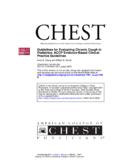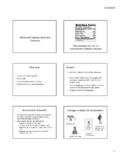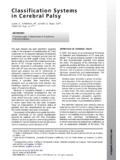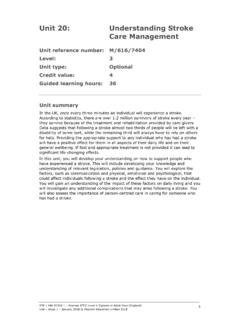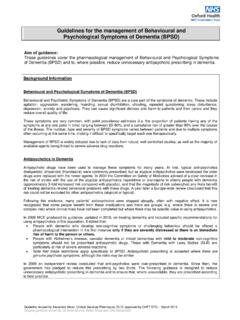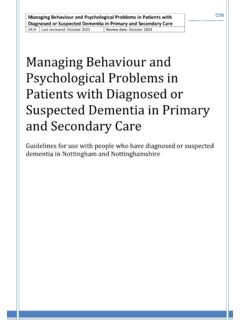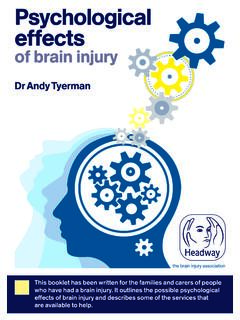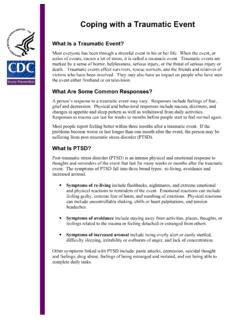Transcription of Parenting Children Who Have Been Exposed To ... - OHSU
1 Non-Return Information Packet Parenting Children Who Have Been Exposed to Methamphetamine A Brief Guide for Adoptive, Guardianship, and Foster Parents Oregon Post Adoption Resource Center 2950 SE Stark Street, Suite 130 Portland, Oregon 97214 503-241-0799 800-764-8367 503-241-0925 Fax ORPARC is a contracted service of the Oregon Department of Human Services. Please do not reproduce without permission. Assisting families on their lifelong journey Parenting Children WHO HAVE BEEN Exposed TO METHAMPHETAMINE A BRIEF GUIDE FOR ADOPTIVE, GUARDIANSHIP AND FOSTER PARENTS Page i Table of Contents Introduction: .. 1 Part I: Methamphetamine: An Overview .. 2 What is meth? What are its effects on the user? How prevalent is meth use? How is meth addiction treated? Part II: Meth s Effects on Children .. 7 What are the prenatal effects of exposure?
2 What are the postnatal effects of prenatal exposure? What are the environmental effects on Children ? Part III: Parenting Meth- Exposed Children .. 11 Guiding principles Age-specific suggestions Part IV: Reprinted Articles .. 20 Appendix A: Recommended Resources Appendix B: Sources Parenting Children WHO HAVE BEEN Exposed TO METHAMPHETAMINE A BRIEF GUIDE FOR ADOPTIVE, GUARDIANSHIP AND FOSTER PARENTS Page 1 Introduction This Information Packet begins with a brief overview of current knowledge regarding the abuse of methamphetamine what it is, how it effects the user, and how addiction is treated. Part Two contains information about the known and suspected effects on the Children of methamphetamine users. It includes both prenatal exposure effects and environmental exposure effects. Part Three offers suggestions for adoptive, guardianship, and foster parents who care for the Children from meth abusing homes.
3 Part Four contains reprints of several articles on the topic, written specifically for foster and adoptive parents. Appendix A is a list of recommended resources for more information. The scientific community is continually discovering more about the effects of this illicit drug on the Children of its users, with new interventions continually explored and recommended. Although the ORPARC staff will attempt to update this packet from time to time, it does not fall within the scope of this program to be a continuing source of the latest medical and scientific information. Readers are encouraged to visit the websites on the Resource List. Many of these, such as the NIH and SAMSHA, will post new findings as soon as they are available. In terms of damage to Children and to our society, meth is now the most dangerous drug in America. Attorney General Alberto Gonzales Parenting Children WHO HAVE BEEN Exposed TO METHAMPHETAMINE A BRIEF GUIDE FOR ADOPTIVE, GUARDIANSHIP AND FOSTER PARENTS Page 2 Part I: Methamphetamine: An Overview What is meth?
4 Methamphetamine, or meth, is a strong, highly addictive central nervous system stimulant. It differs from other illicit stimulants such as cocaine or heroine in that it is synthetically processed, using toxic and flammable chemicals. Meth can be injected, snorted, smoked, or swallowed. The highly addictive nature of meth is attributed to its powerful and immediate release of dopamine into the brain of the user. Dopamine is a chemical that creates feelings of well being. You may be familiar with the effects of dopamine if you have experienced the strong emotional satisfaction that follows a vigorous physical workout. The dopamine released into the brain after physical exertion is just a tiny fraction of the amount released in response to meth. The exorbitant amount and the almost immediate release of dopamine in response to meth creates extreme feelings of omnipotence and euphoria. In its August 2005 expose, Newsweek stated that meth seduces its users with a euphoric rush of confidence, hyperalertness, and sexiness that lasts for hours on end.
5 Meth is stronger and cheaper than cocaine. Researchers tell us that the amount of dopamine released by meth use is three times that released through cocaine use, and four times that released through morphine use. What are its effects on the user? Meth creates a short but intense rush when it first enters the body. Users experience increased activity, decreased appetite, and strong feelings of well being, energy, and power, lasting from 20 minutes to 12 hours. As the effects wear off, the drug leaves the user feeling drained, helpless, and deeply depressed, 1 and craving the drug again. Meth brings to its users serious physical, psychological , and cognitive effects. Short term physical effects: Strong and quick addition Insomnia Increased pulse, blood pressure, respiration Decreased reaction time Large doses can cause: Convulsions stroke Overheating Heart Attack Death 1 America s Most Dangerous Drug.
6 Newsweek. Aug 8, 05. Parenting Children WHO HAVE BEEN Exposed TO METHAMPHETAMINE A BRIEF GUIDE FOR ADOPTIVE, GUARDIANSHIP AND FOSTER PARENTS Page 3 Long term physical effects: Weakness, tremors, seizures Dental decay Weight loss; anorexia Coughing, dry mouth Rapid facial aging Brain damage Kidney damage Liver damage Heart damage Skin sores and infection Increased risk of stroke Increased risk of HIV and hepatitis Cognitive Effects Include Decreased Ability to: Recognize and recall words and pictures Make inferences Manipulate information Learn from experience Ignore irrelevant information Short term psychological effects: Increased confidence Increased alertness Increased good mood Increased sex drive Increased talkativeness Decreased boredom, loneliness The brain damage caused by chronic meth use can also lead to: Long term psychological effects: Insomnia Aggression Anxiety Confusion Mood disorders Psychotic behavior: which may include hallucinations, delusions, paranoia, homicidal or suicidal thoughts A few observations on these effects: The appeal of meth might be understandable in light of its short term psychological effects.
7 Persons who are socially isolated, or who suffer from shyness or low self esteem, may be particularly vulnerable as they perceive increased confidence as a result of meth use. But meth is an equal opportunity drug. Its users include those on all rungs of the socioeconomic ladder and all races and backgrounds. The damage to the brain by chronic meth use is detectable even months after usage. Scientists have found the brain damage caused by meth to be similar to the damage caused by Alzheimer s disease, stroke , and epilepsy. Brain scans performed on users after ten years of meth use show destruction in the Limbic brain system, which regulates emotion, and in the Hippocampus, which aids memory. Experts believe the limbic system damage leads to long term depression and anxiety, while the hippocampus damage leads to symptoms similar to early Alzheimer s disease. Parenting Children WHO HAVE BEEN Exposed TO METHAMPHETAMINE A BRIEF GUIDE FOR ADOPTIVE, GUARDIANSHIP AND FOSTER PARENTS Page 4 Some Societal Effects: Increase in (violent) criminal activity Increase in domestic violence Increase in child abuse and neglect Increase in identity theft Endangerment due to chemical exposure Burns, maiming or death from volatile toxic chemicals, fires, lab explosions Pollution of air and ground due to toxic chemicals and vapors Withdrawal symptoms include.
8 Depression Anxiety Fatigue Paranoia Aggression Intense cravings How prevalent is meth use? A 2005 White House Drug Policy paper calls methamphetamine the most prevalent synthetic drug manufactured in the United States, and attributes both its highly addictive nature and the ease in which it can be manufactured to its increased usage Two recent national surveys on methamphetamine usage report these findings: 2004 National Survey on Drug Use and Health3 Lifetime (used at least once) Annual (used in past year) Monthly (used in past 30 Days) US residents ages 12+ High School Students Reporting Methamphetamine Use, 20044 Grade Lifetime (used at least once) Annual (used in past year) Monthly (used in past 30 Days) 8th 10th 12th % 2 Methamphetamines.
9 Drug Facts 2005. Office of National Drug Control Policy. 3 Results from the 2004 National Survey of Drug Use and Health: National Findings. Substance Abuse and Mental Health Services Administration., Sept 2005. 4 Monitoring the Future 2004 Data From In-School Surveys of 8th, 10th,and 12th Grade Students. National Institute on Drug Abuse and University of Michigan. Dec 2004. Parenting Children WHO HAVE BEEN Exposed TO METHAMPHETAMINE A BRIEF GUIDE FOR ADOPTIVE, GUARDIANSHIP AND FOSTER PARENTS Page 5 Note the disconcerting frequency of use among 10th and 12th graders compared to the usage for all persons over age 12. However, meth use among high schoolers has decreased over the past two years. The rate of usage among high schoolers in 2004 was slightly lower than a similar 2003 survey, in which the percentage of students who used meth at least once was for all high school grades combined. That survey also yielded demographic information about who uses meth: Male students ( ) were more likely than female students ( ) to report lifetime methamphetamine use.
10 Hispanic ( ) and white ( ) students were more likely than black ( ) students to use methamphetamine within their A 2003 survey of meth use among college students and non-college young adults yielded these statistics: Ages/grades Lifetime (used at least once) Annual (used in past year) Monthly (used in past 30 Days) College students Young adults (19-28) Meth use started in rural areas and on the West Coast, but it has spread across the states; it has reached epidemic proportions in most large urban areas and it is seeping steadily into the suburbs. Nationwide, law enforcement officers rank meth as the top drug they battle. Meth usage seems to know no demographic boundaries. A tablet form of meth is gaining popularity as a club drug, perhaps replacing the drug ecstasy in popularity with young adults on the rave scene. Woman of varied ages have succumbed to meth s lure of assured weight loss. Young women in particular may also turn to meth to handle depression.


